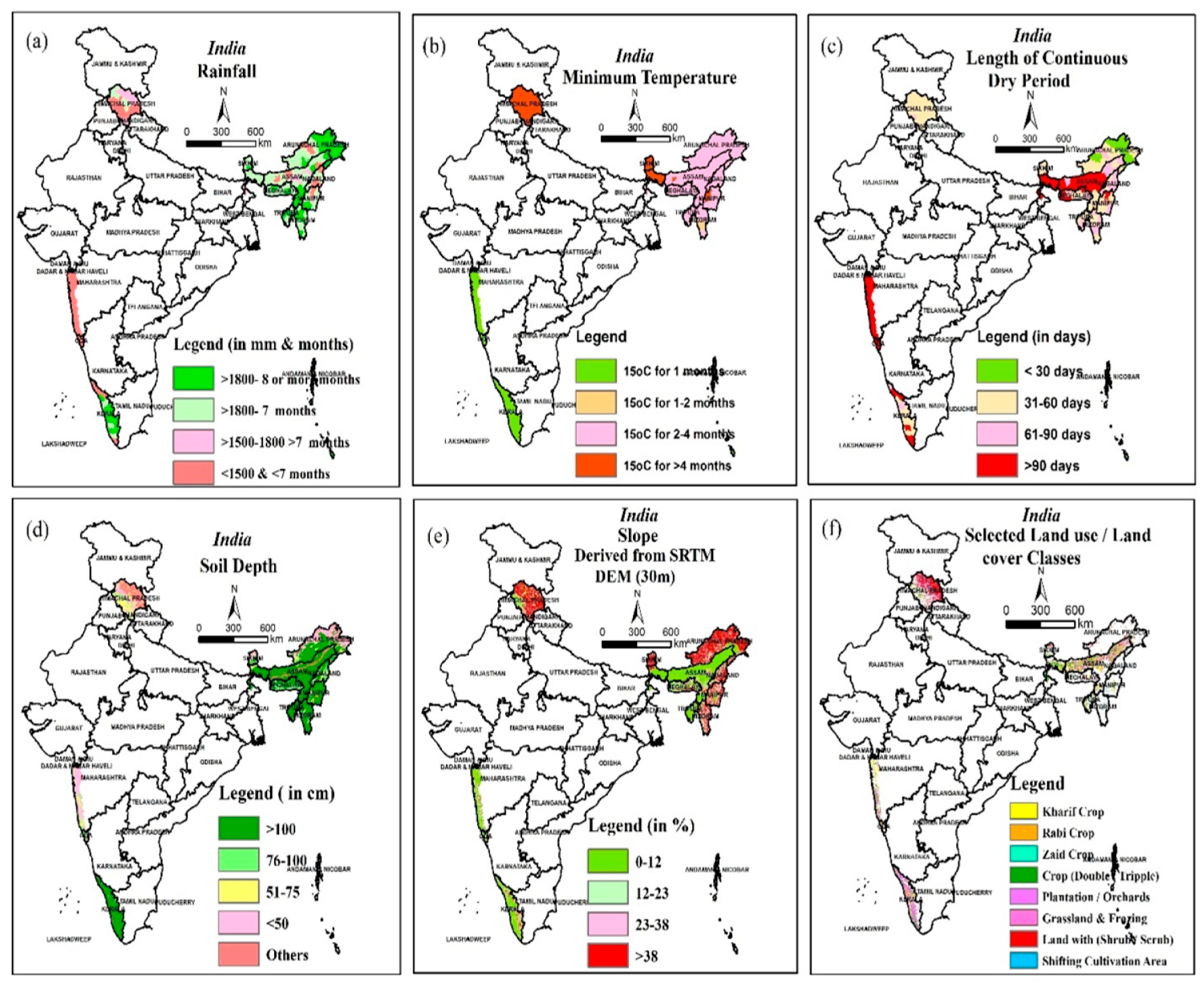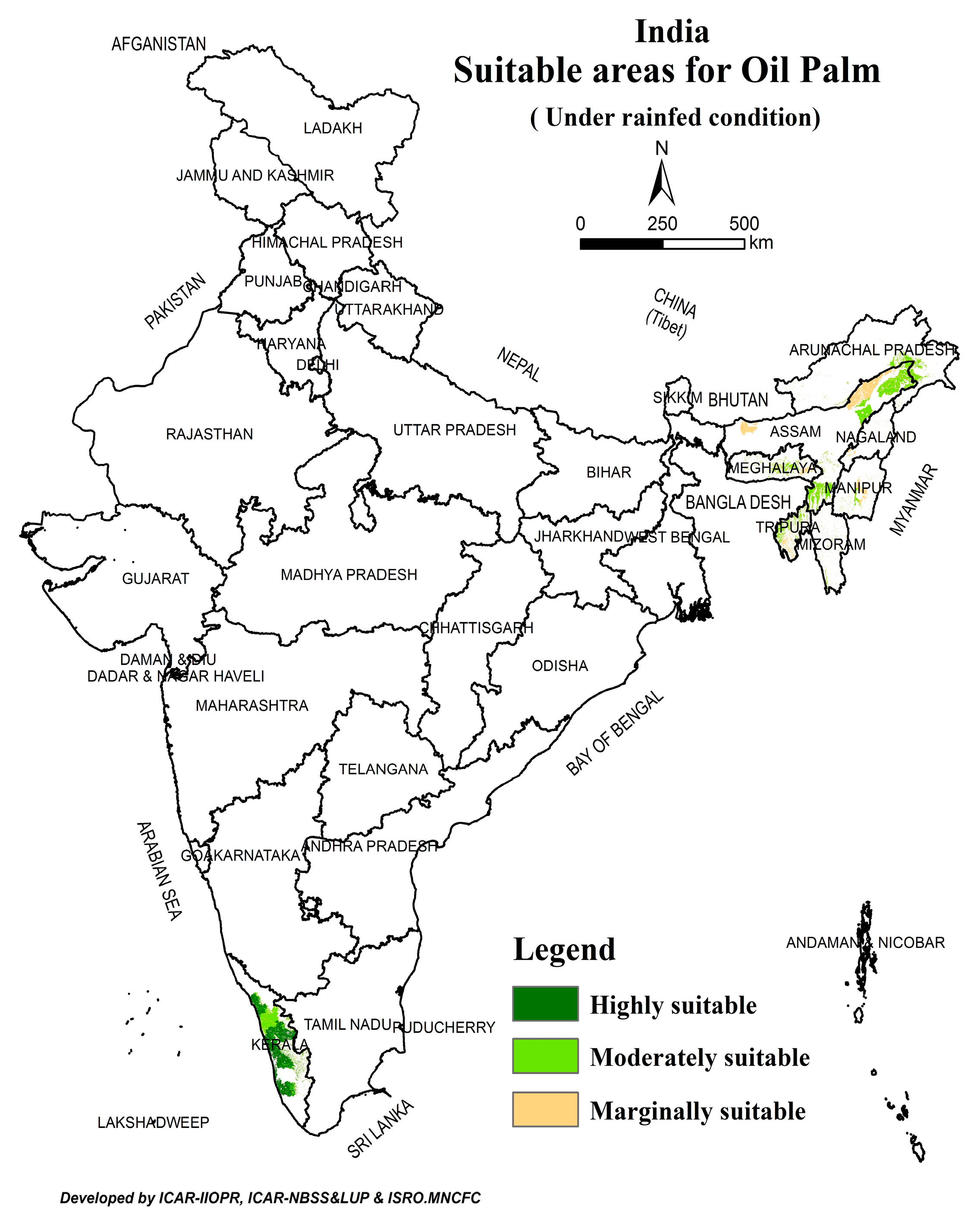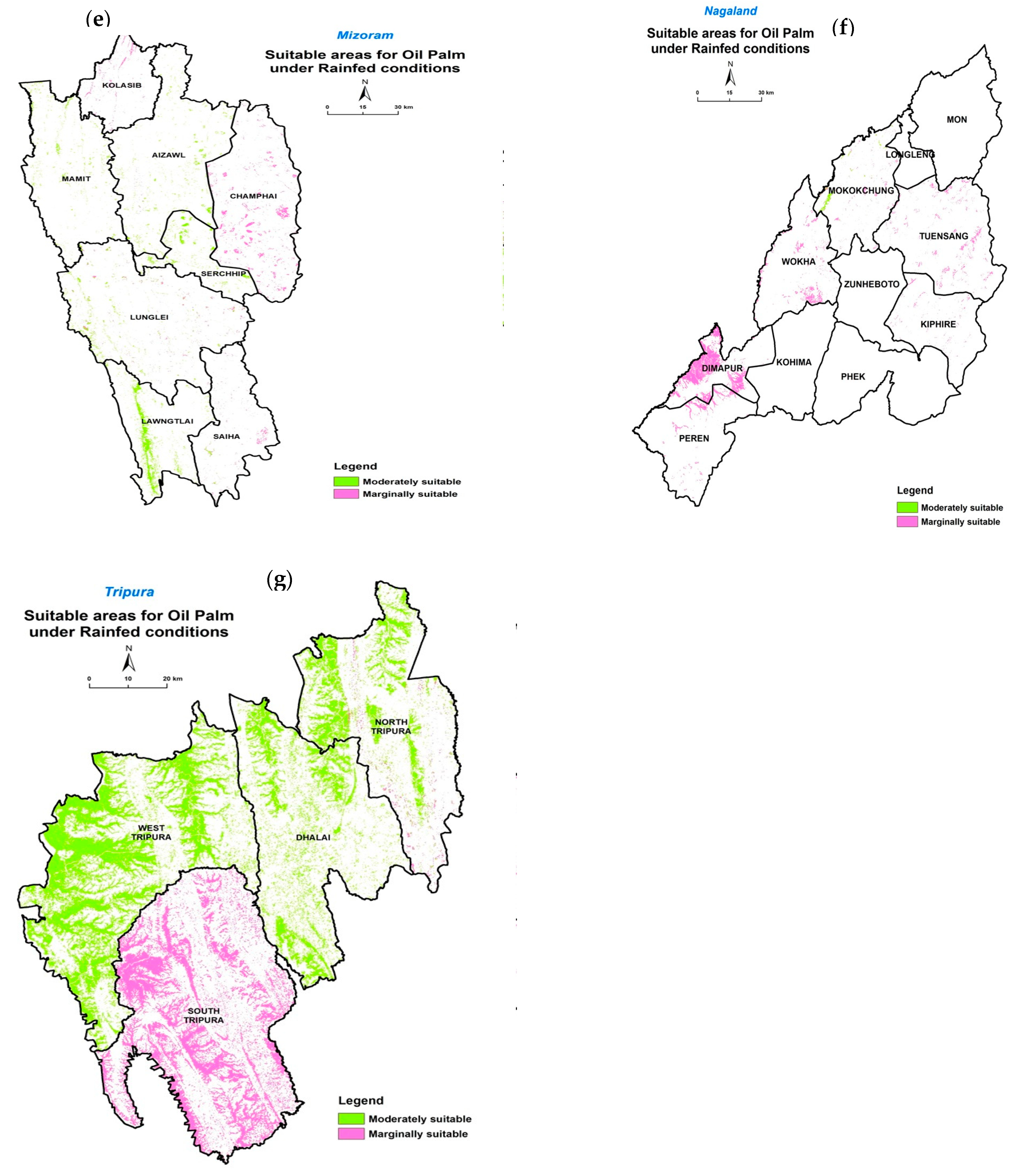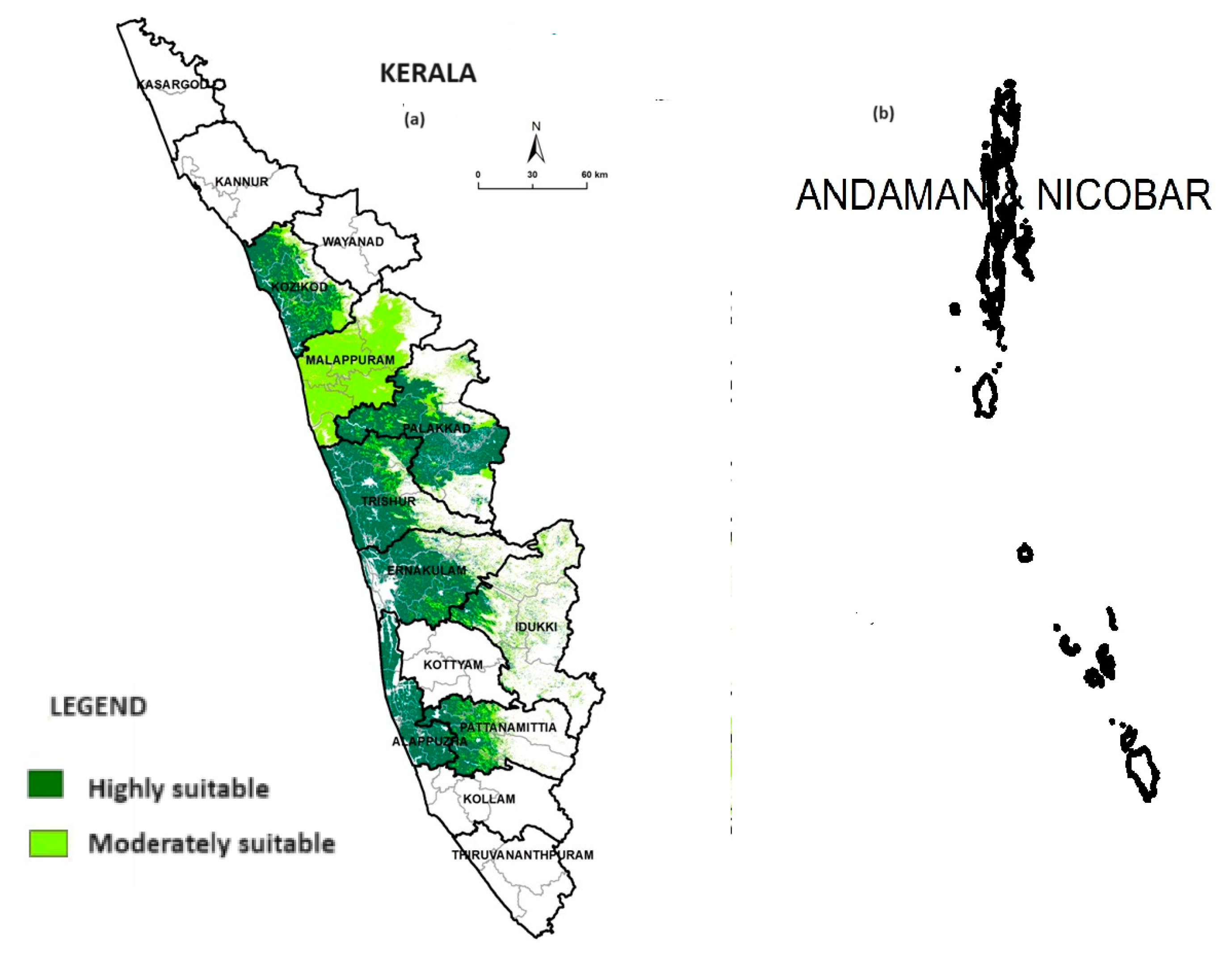Characterization and Mapping of the Potential Area of Oil Palm Using Multi-Criteria Decision Analysis in a Geographic Information Systems Environment
Abstract
1. Introduction
2. Materials and Methods
2.1. Study Area
2.2. Selection of Critical Parameters (Factors), Classification, Weights and Scores
2.3. Spatial Data Sources
2.4. Methodology Adopted
2.4.1. Development of Thematic Rasters
2.4.2. GIS-Based Modeling for Oil Palm Suitability Using MCDA
2.5. Area Computations
2.6. Model Validation
Schema of Methodology
3. Results
3.1. Suitable States and Constraints
3.2. Area under Different Classes of Suitability
3.3. State-Wise Potential Areas
3.3.1. North-Eastern States
3.3.2. Southern India
3.4. Model Validation
4. Discussion and Perspectives
5. Conclusions
Author Contributions
Funding
Data Availability Statement
Conflicts of Interest
References
- NMEO-OP. 2021. Available online: https://nfsm.gov.in/Guidelines/NMEO-OPGUIEDELINES.pdf (accessed on 14 November 2022).
- Sujatha, M.; Sudhakara Babu, S.N.; Kumar, G.D.S. Strategies for enhancing production and productivity of annual oilseeds in India. In Proceedings of the Souvenir of International Conference on Vegetable Oils 2023, Hyderabad, India, 17–21 January 2023; pp. 1–11. [Google Scholar]
- Thakur, S. Moving towards self sufficiency in edible oils. In Proceedings of the Souvenir of International Conference on Vegetable Oils 2023, Hyderabad, India, 17–21 January 2023; pp. 12–17. [Google Scholar]
- Mathur, R.K.; Manorama, K.; Mary Rani, K.L.; Suresh, K. Technological interventions in oil palm—The way forward towards attaining self-sufficiency in edible oil production. In Proceedings of the Souvenir National Seminar—2020 on “Technological Innovations in Oil Seed Crops for Enhancing Productivity, Profitability and Nutritional Security”, Hyderabad, India, 7–8 February 2020; pp. 41–48. [Google Scholar]
- Prasad, M.V.; Suresh, K. Oil palm Research and Development Activities—Aspirations. In Proceedings of the Souvenir of International Conference on Vegetable Oils 2023, Hyderabad, India, 17–21 January 2023; pp. 38–41. [Google Scholar]
- Reddy, B.M.C.; Ray, S.S.; Arulraj, S.; Mathur, R.K. Reassessment Report. In Reassessment of Potential Areas for Oil Palm Cultivation in India and Revision of Targets Upwards; ICAR-IIOPR: Pedavegi, India, 2020; p. 132. ISBN 81-87561-59-9. [Google Scholar]
- Suresh, K.; Mathur, R.K.; Manorama, K. Yield gap analysis in oil palm. In Recent Advances in Oil Palm Production and Special Emphasis on Emergence of New Pest and Its Management; CRC Press: Boca Raton, FL, USA, 2019; pp. 111–114. ISBN 81-87561-58-0. [Google Scholar]
- Gurmessa, M.M.; Moisa, M.B.; Boru, L.H.; Deribew, K.T.; Roba, Z.R.; Negasa, J.J.; Tiye, F.S.; Gemeda, D.O. Geospatial assessment of potential land suitability for oil palm (Elaeis guineensis Jacq) cultivation in the western parts of Ethiopia. OCL 2023, 30, 23. [Google Scholar] [CrossRef]
- Singha, C.; Swain, K.C. Land suitability evaluation criteria for agricultural crop selection: A review. Agric. Rev. 2016, 37, 125–132. [Google Scholar] [CrossRef]
- Naidu, L.G.K.; Ramamurthy, V.; Challa, O.; Hegde, R.; Krishnan, P. Manual on Soil-Site Suitability Criteria for Major Crops; National Bureau of Soil Survey and Land Use Planning (ICAR): Nagpur, India, 2006; Available online: https://www.scirp.org/reference/referencespapers?referenceid=2757441 (accessed on 5 May 2024).
- Mendas, A.; Delali, A. Integration of multi-criteria decision analysis in GIS to develop land suitability for agriculture: Application to durum wheat cultivation in the region of Mleta in Algeria. Comput. Electron. Agric. 2012, 83, 117–126. [Google Scholar] [CrossRef]
- Saha, S.; Mondal, P. Estimation of the effectiveness of multi-criteria decision analysis and machine learning approaches for agricultural land capability in Gangarampur Subdivision, Eastern India. Artif. Intell. Geosci. 2022, 3, 179–191. [Google Scholar] [CrossRef]
- Zhang, J.; Su, Y.; Wu, J.; Liang, H. GIS based land suitability assessment for tobacco production using AHP and fuzzy set in Shandong province of China. Comput. Electron. Agric. 2015, 114, 202–211. [Google Scholar] [CrossRef]
- Benezoli, V.H.; Imbuzeiro, H.M.A.; Cuadra, S.V.; Colmanetti, M.A.A.; de Araújo, A.C.; Stiegler, C.; Motoike, S.Y. Modeling oil palm crop for Brazilian climate conditions. Agric. Syst. 2021, 190, 103130. [Google Scholar] [CrossRef]
- ElSheik, R.A.; Ahmad, N.; Shariff, A.; Balasundra, S.; Yahaya, S. An agricultural investment map based on geographic information system and multi-criteria method. J. Appl. Sci. 2010, 10, 1596–1602. [Google Scholar] [CrossRef][Green Version]
- Baja, S.; Chapman, D.M.; Dragovich, D. A conceptual model for defining and assessing land management units using a fuzzy modeling approach in GIS environment. Environ. Manag. 2002, 29, 647–661. [Google Scholar] [CrossRef] [PubMed]
- Salem, M.Z.; Ageeb, G.W.; Rahim, I.S. Land suitability for agricultural of certain crops in Albostan area, Egypt. Res. J. Agric. Biol. Sci. 2008, 4, 485–499. [Google Scholar]
- Pan, G.; Pan, J. Research in crop land suitability analysis based on GIS. Comp. Technol. Agric. 2012, 365, 314–325. [Google Scholar] [CrossRef]
- Jiang, H.; Eastman, J.R. Application of fuzzy measures in multi-criteria evaluation in GIS. Int. J. Geogr. Inf. Sci. 2000, 14, 173–184. [Google Scholar] [CrossRef]
- Janssen, R.; Reitveld, P. Multi-criteria analysis and geographical information systems. An application to agricultural land use in the Netherlands. In Geographical Information Systems for Urban and Regional Planning; Scholten, H.J., Stillwell, J.C.H., Eds.; Kluwer Academic Publishers: Dordrecht, The Netherlands, 1990; pp. 129–139. [Google Scholar]
- Chen, H.-S.; Liu, G.-S.; Yang, Y.-F.; Ye, X.-F.; Shi, Z. Comprehensive evaluation of tobacco ecological suitability of Henan province based on GIS. Agric. Sci. China 2010, 9, 583–592. [Google Scholar] [CrossRef]
- Jayasinghe, S.L.; Kumar, L.; Sandamali, J. Assessment of Potential Land Suitability for Tea (Camellia sinensis (L.) O. Kuntze) in Sri Lanka Using a GIS-Based Multi-Criteria Approach. Agriculture 2019, 9, 148. [Google Scholar] [CrossRef]
- Ramamurthy, V.; Reddy, G.P.O.; Kumar, N. Assessment of land suitability for maize (Zea mays L) in semi-arid ecosystem of Southern India using integrated AHP and GIS approach. Comput. Electron. Agric. 2020, 179, 105806. [Google Scholar] [CrossRef]
- Tshabalala, T.; Ncube, B.; Moyo, H.P.; Abdel Rahman, E.M.; Mutanga, O.; Ndhlala, A.R. Predicting the spatial suitability distribution of Moringa oleifera cultivation using analytical hierarchical process modelling. S. Afr. J. Bot. 2020, 129, 161–168. [Google Scholar] [CrossRef]
- Malczewski, J. GIS-based land-use suitability analysis: A critical overview. Prog. Plan. 2004, 62, 3–65. [Google Scholar] [CrossRef]
- Reddy, G.P.O. Spatial data management, analysis, and modeling in GIS: Principles and applications. In Geospatial Technologies in Land Resources Mapping, Monitoring and Management; Reddy, G.P.O., Singh, S.K., Eds.; Geotechnologies and the Environment; Springer: Cham, Switzerland, 2018; Volume 21, pp. 127–142. [Google Scholar]
- Carr, M.K.V. The water relations and irrigation requirements of oil palm (Elaeis guineensis): A review, Experiment Agriculture. Exp. Agric. 2011, 47, 629. [Google Scholar] [CrossRef]
- Lim, K.H.; Goh, K.J.; Kee, K.K.; Henson, I.E. Climatic Requirements of Oil Palm. 1957. Available online: https://www.researchgate.net/publication/308054675_Climatic_requirements_of_oil_palm (accessed on 30 January 2020).
- Boonyanuhap, J.; Det, W.; Sakurai, K. GIS based land suitability assessment for (MUSACABB group) plantation. J. Appl. Hort. 2004, 6, 3–10. [Google Scholar] [CrossRef]
- FAO. A Framework for Land Evaluation; FAO: Rome, Italy, 1976; Available online: https://www2.alterra.wur.nl/Internet/webdocs/ilri-publicaties/publicaties/Pub22/pub22-h1.pdf (accessed on 5 May 2024).
- Djaenudin, D.; Marwan, H.; Subagyo, H.; Hichyat, A. Guidelines of Land Evaluation for Agricultural Crops; Soil Research and Agro-Climate Center: Bogor, Indonesia, 2003. [Google Scholar]
- ESRI. ArcGIS Ver 10.3; Environmental Systems Research Institute: Redlands, CA, USA, 2015. [Google Scholar]
- Pirker, J.; Mosnier, A.; Kraxner, F.; Havlík, P.; Obersteiner, M. What are the limits to oil palm expansion? Glob. Environ. Change 2016, 40, 73–81. [Google Scholar] [CrossRef]
- Paramananthan, S. Soil requirements of oil palm for high yields. In Managing Oil Palm for High Yields: Agronomic Principles; Goh, K.J., Ed.; Malaysian Society of Soil Science and Param Agricultural Surveys: Kaulalumpur, Malaysia, 2000; pp. 18–38. [Google Scholar]
- Reddy, V.M.; Suresh, K.; Sarma, K.N.; Sivasankara Kumar, K.M.; Bhanusri, A.; Ramakrishna, P. Root biomass distribution in relation to its moisture pattern under different irrigation methods in oil palm. In Proceedings of the 15th Plantation Crops Symposium (Placrosym XV), Mysore, India, 10–13 December 2002; pp. 344–347. [Google Scholar]
- Corley, R.H.V.; Tinker, P.B. (Eds.) The Oil Palm, 5th ed.; John Wiley & Sons: Hoboken, NJ, USA, 2016; ISBN 978-1-405-18939-2. [Google Scholar]
- Hartley, C.W.S. The Oil Palm (Elaeis guineensis Jacq.); Longman Group Limited: London, UK, 1988. [Google Scholar]
- Suresh, K.; Reddy, V.M.; Sarma, K.N.; Bhanusri, A.; Sivasankara Kumar, K.M. Quantification of root biomass in oil palm grown under basin irrigation. Int. J. Oil Palm 2003, 2, 39–41. [Google Scholar]
- Manorama, K.; Chandran, K.P.; Mathur, R.K.; Suresh, K.; Behera, S.K. Efficient plot size for oil palm (Elaeis guineensis Jacq.) field experiments. J. Oil Seeds Res. 2019, 36, 250–257. Available online: https://epubs.icar.org.in/index.php/JOR/article/view/136708 (accessed on 5 May 2024).
- Goh, K.J.; Chew, P.S.; Teo, C.B. Maximising and maintaining oil palm yields on commercial scale in Malaysia. In ISP Planters’ Conference on Managing Oil Palms 41 for Enhanced Profitability; Chee, K.H., Ed.; ISP: Kuala Lumpur, Malaysia, 1994; pp. 121–141. [Google Scholar]
- Fairhurst, T.H.; Mclaughlin, D. Sustainable Oil Palm Development on Degraded Land in Kalimantan; World Wildlife Fund: Washington, DC, USA, 2009; Available online: https://assets.worldwildlife.org/publications/355/files/original/Sustainable_Oil_Palm_Development_on_Degraded_Land_in_Kalimantan__Indonesia.pdf?1345735065 (accessed on 5 May 2024).
- Paramananthan, S. Managing marginal soils for sustainable growth of oil palms in the tropics. J. Oil Palm Environ. 2013, 4, 1–16. [Google Scholar] [CrossRef]
- Olivin, J. Étude pour la localisation d’un bloc industriel de palmiers à huile. Oléagineux 1968, 23, 499–504. [Google Scholar]
- Lim, K.H.; Goh, K.J.; Kee, K.K.; Henson, I.E. Climatic requirements of oil palm. In Agronomic Principles and Practices of Oil Palm Cultivation; Goh, K.-J., Chiu, S.-B., Paramananthan, S., Eds.; Wiley: Hoboken, NJ, USA, 2015; pp. 1–48. ISBN 978-983-43384-1-1. [Google Scholar]
- Kee, K.K. Regional rainfall pattern and climatic limitations for plantation crops in Peninsular Malaysia. Planter 1995, 71, 67–78. [Google Scholar]
- Suresh, K.; Mathur, R.K.; Manorama, K. History of oil palm in Indian edible oil scenario—R & D. In Recent Advances in Oil Palm Production and Special Emphasis on Emergence of New Pest and Its Management; CRC Press: Boca Raton, FL, USA, 2019; pp. 1–9. ISBN 81-87561-58-0. [Google Scholar]
- Uning, R.; Latif, M.T.; Othman, M.; Juneng, L.; Mohd Hanif, N.; Nadzir, M.S.M.; Abdul Maulud, K.N.; Jaafar, W.S.W.M.; Said, N.F.S.; Ahamad, F. A Review of Southeast Asian Oil Palm and Its CO2 Fluxes. Sustainability 2020, 12, 5077. [Google Scholar] [CrossRef]
- Chow, C.S.; Chang, K.C. Effects of sunshine hours on oil extraction rate with special reference to the haze in recent years. In National Seminar on Opportunities for Maximising Production through Better OER and Offshore Investment in Oil Palm; PORIM: Bangi, Selangor, Malaysia, 1999; pp. 244–253. [Google Scholar]
- Prabowo, N.E.; Foster, H.L. Variation in oil and kernel extraction rates of oil palms in North Sumatra due to nutritional and climatic factors. In Proceedings of the 1998 International Oil Palm Conference. Commodity of the Past, Today, and the Future, Bali, Indonesia, 23–25 September 1998; pp. 275–286. [Google Scholar]
- Naidoo, K.; Adam, S. Mapping suitability areas for oil palm cultivation using GIS-based multi-criteria decision analysis. S. Afr. J. Geomat. 2016, 5, 315–328. [Google Scholar]
- Saadatian, O.; Shahraki, S.; Shahabi, H. Site suitability analysis for oil palm cultivation using GIS and multi-criteria decision-making techniques: A case study in South Sumatra Province, Indonesia. Geocarto Int. 2017, 32, 355–373. [Google Scholar]
- Duc, T.T. Using GIS and AHP technique for land-use suitability analysis. In Proceedings of the International Symposium on Geoinformatics for Spatial Infrastructure Development in Earth and Allied Sciences, Ho Chi Minh City, Vietnam, 9–11 November 2006; pp. 1–6. Available online: https://citeseerx.ist.psu.edu/viewdoc/download?doi=10.1.1.468.4502&rep=rep1&type=pdf (accessed on 5 May 2024).
- Shi, Z.; Guan, Y.L.; Wang, Y.G.; Huang, M.X.; Gong, J.Q.; Wang, L.H. Adjustment of citrus planting structure supported by the integrated remote sensing and GIS. Econ. Geog. 2002, 22, 727–730. (In Chinese) [Google Scholar]
- Mantel, S.; Wosten, H.; Verhagen, J. Biophysical Land Suitability for Oil Palm in Kalimantan, Indonesia; Wiley: Hoboken, NJ, USA, 2007. [Google Scholar]
- Rhebergen, T.; Fairhurst, T.; Zingore, S.; Fisher, M.; Oberthür, T.; Whitbread, A. Climate, soil and land-use based land suitability evaluation for oil palm production in Ghana. Eur. J. Agron. 2016, 81, 1–14. [Google Scholar] [CrossRef]
- Ogunkunle, A.O. Soil in land suitability evaluation: An example with oil palm in Nigeria. Soil Use Manag. 1993, 9, 35–39. [Google Scholar] [CrossRef]
- Abraham, A.; Bamweyana, I. Geospatial Assessment of Land Suitability for Oil Palm (Elaeis guineensis Jacq.) Growing in Northern Uganda. S. Afr. J. Geomat. 2022, 11, 310–324. [Google Scholar] [CrossRef]









| Critical Parameter and Rank | Per Cent Weight Assigned (%) | Sub-Classes | |||
|---|---|---|---|---|---|
| Highly Suitable | Moderately Suitable | Marginally Suitable | Not Suitable | ||
| 1. Mean annual rainfall | 45 | >1800 mm in 8 or more months | >1800 mm in 7 months | >1500–1800 mm in >7 months | <1500 mm in <7 months (Restricted) |
| 2. Months with <15° C minimum temperature | 20 | <15 °C for <1 month | <15 °C for 1–2 months | <15 °C for 2–4 months | <15 °C for >4 months |
| 3. Slope (%) | 15 | 0–12 (0–6°) | 12–23 (6–12°) | 23–38 (12–20°) | >38 (20°) (Restricted) |
| 4. Length of continuous dry period | 10 | <30 days | 31–60 days | 61–90 days | >90 days |
| 5. Depth of soil | 10 | >100 cm | 76–100 cm | 50–75 cm | <50 cm |
| Input Parameters | % Influence | Class | Scale Value |
|---|---|---|---|
| Annual rainfall (normal) | 45 | 1 | 9 |
| 2 | 7 | ||
| 3 | 5 | ||
| 4 | Restricted | ||
| Nodata | Nodata | ||
| Months with <15 °C Minimum temperature | 20 | 1 | 9 |
| 2 | 7 | ||
| 3 | 4 | ||
| 4 | Restricted | ||
| Nodata | Nodata | ||
| Slope | 15 | 1 | 9 |
| 2 | 7 | ||
| 3 | 4 | ||
| 4 | Restricted | ||
| Nodata | Nodata | ||
| Length of continuous dry period (number of days) | 10 | 1 | 9 |
| 2 | 4 | ||
| 3 | 2 | ||
| 4 | Restricted | ||
| Nodata | Nodata | ||
| Soil depth | 10 | 1 | 9 |
| 2 | 7 | ||
| 3 | 3 | ||
| 4 | Restricted | ||
| 5 | Restricted | ||
| Nodata | Nodata |
Disclaimer/Publisher’s Note: The statements, opinions and data contained in all publications are solely those of the individual author(s) and contributor(s) and not of MDPI and/or the editor(s). MDPI and/or the editor(s) disclaim responsibility for any injury to people or property resulting from any ideas, methods, instructions or products referred to in the content. |
© 2024 by the authors. Licensee MDPI, Basel, Switzerland. This article is an open access article distributed under the terms and conditions of the Creative Commons Attribution (CC BY) license (https://creativecommons.org/licenses/by/4.0/).
Share and Cite
Manorama, K.; Reddy, G.P.O.; Suresh, K.; Ray, S.S.; Behera, S.K.; Kumar, N.; Mathur, R.K. Characterization and Mapping of the Potential Area of Oil Palm Using Multi-Criteria Decision Analysis in a Geographic Information Systems Environment. Agriculture 2024, 14, 986. https://doi.org/10.3390/agriculture14070986
Manorama K, Reddy GPO, Suresh K, Ray SS, Behera SK, Kumar N, Mathur RK. Characterization and Mapping of the Potential Area of Oil Palm Using Multi-Criteria Decision Analysis in a Geographic Information Systems Environment. Agriculture. 2024; 14(7):986. https://doi.org/10.3390/agriculture14070986
Chicago/Turabian StyleManorama, Kamireddy, G. P. Obi Reddy, K. Suresh, S. S. Ray, S. K. Behera, Nirmal Kumar, and R. K. Mathur. 2024. "Characterization and Mapping of the Potential Area of Oil Palm Using Multi-Criteria Decision Analysis in a Geographic Information Systems Environment" Agriculture 14, no. 7: 986. https://doi.org/10.3390/agriculture14070986
APA StyleManorama, K., Reddy, G. P. O., Suresh, K., Ray, S. S., Behera, S. K., Kumar, N., & Mathur, R. K. (2024). Characterization and Mapping of the Potential Area of Oil Palm Using Multi-Criteria Decision Analysis in a Geographic Information Systems Environment. Agriculture, 14(7), 986. https://doi.org/10.3390/agriculture14070986





